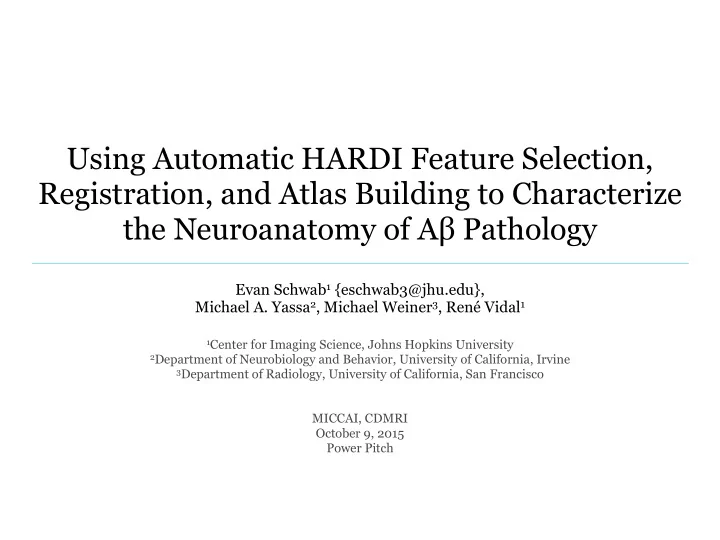

Using Automatic HARDI Feature Selection, Registration, and Atlas Building to Characterize the Neuroanatomy of A β Pathology Evan Schwab 1 {eschwab3@jhu.edu}, Michael A. Yassa 2 , Michael Weiner 3 , René Vidal 1 1 Center for Imaging Science, Johns Hopkins University 2 Department of Neurobiology and Behavior, University of California, Irvine 3 Department of Radiology, University of California, San Francisco MICCAI, CDMRI October 9, 2015 Power Pitch
HARDI: From DWI to A. Diffusion Weighted Images Feature Analysis S ( θ 1 , φ 1 ) S ( θ 2 , φ 2 ) S ( θ 3 , φ 3 ) S ( θ 4 , φ 4 ) Goal: Develop methods to automatically • extract a set of interpretable and discriminative features from HARDI for B. Orientation Distribution Functions disease classification. p ( ϑ , ϕ ) Prior Work: Register subject data to a • common atlas, extract simple features in registered space, and use them to train a C. Scalar Feature Vectors classifier. Question 1: At what stage (A, B, or C) should • registration and atlas building be done to optimize feature analysis and processing? D. Feature Analysis Question 2: How should the most • Population 1 Population 2 biologically informative features be selected? Idea: Select features that are important for • both registration, atlas construction and disease classification.
} = 1 , Atlas (0) = Subject i , Features c = { 4 , 10 , 12 , 27 } Start : { W (0) Optimize Processing c 1. Register Subjects to Current Atlas with Current Weights for Feature Analysis } = θ ( k ) mcLDDMM { W ( k ) c i Atlas ( k ) Subject i Solution: An automatic method for joint • HARDI feature selection, registration and atlas building. 2. Take Average of Subjects in Atlas Space Average ( k ) Advantages: • 1 Subject i � θ ( k ) X • Automatically selects anatomically i N informative features driven by i registration and not disease specific. 3. Calculate Error of Registration to Estimate New Weights • Preserves and optimizes feature data 1 || Subject i � θ ( k ) { W ( k +1) throughout processing. X � Atlas ( k ) || } i c N i • Registers HARDI while bypassing the 4. With Updated Weights and Average, Create New Atlas need for re-orientation and re- estimation of diffusion data. mcLDDMM { W ( k +1) } = µ ( k +1) Average ( k ) Atlas (0) c • Generalizes to features extracted using any dMRI acquisition, signal reconstruction and diffusivity profile Atlas ( k +1) estimation methods. Atlas (0) � µ ( k +1) • Constructs novel feature atlases. } , Atlas ( K ) End : { W ( K ) c
Recommend
More recommend